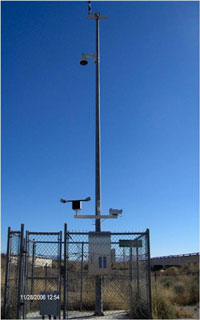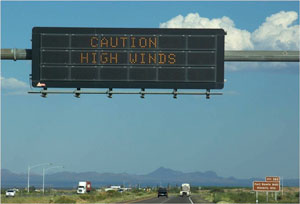Best Practices for Road Weather Management
Arizona DOT DUST Warning System
One of the biggest challenges for road weather management along Interstate 10 (I-10) is dust storms. Currently, in the spring of each year these often unpredictable events wreak havoc on travel along I-10. Dust storms are an important safety concern in the region, especially for out-of-state drivers who are unfamiliar with this phenomenon. These dust storms can reduce visibility to extremely low levels, causing multiple-car accidents.
The Arizona Department of Transportation (ADOT) has developed the Dual Use Safety Technology (DUST) Warning System to help reduce the loss of life, injury, and property damage on rural I-10 in Cochise County between the communities of Bowie and San Simon. The system has been designed to focus on dual challenges:
- Visibility hazards caused by blowing dust on a sixty mile segment of I-10 between Bowie and the New Mexico Stateline.
- Unexpected snow and ice in the Texas Canyon area of I-10.
The DUST Warning System provides an early warning and detection for icy conditions in Texas Canyon as well as wind borne dust along I-10 using several Environmental Sensor Stations (ESS) and a comprehensive sensor array. Each ESS site is equipped with a snapshot Closed Caption Television (CCTV) camera to visually confirm any potential low visibility conditions.
System Components: The enabling technologies that are integrated to form the DUST Warning System include:
-
Wireless Ethernet Networks—Based on the WIMAX IEEE 802.16 standard, the wireless network solution is integrated to serve as a cost-effective and reliable long-range communications backbone for the DUST Warning System.
-
Photovoltaic Cells—Power for the remote telemetry sites are derived from renewable solar energy generated using photovoltaic cells. Initially developed to power satellites, the technology has gained recent widespread acceptance for solar powered remote telemetry and warning applications.
-
Anemometers—These devices measure wind speed to predict the potential for on-set of high wind conditions, which may lead to reduced visibility conditions.
-
Forward Scatter Visibility Sensors Technology—It uses the forward scatter principle of light in the presence of atmospheric particles to measure the extinction coefficient and visibility. A high-intensity infrared Light Emitting Diode (LED) transmitter is used to illuminate the sensor’s scatter volume. This results in a high signal-to-noise ratio and reduces the effects of background light variations. Visibility measurements are possible over a standard range up to more than 10 miles as depicted in Figure AZ-1.
-
Light Emitting Diodes—LEDs have been in use as indicators for decades. As the reliability, heat tolerance, brightness and efficiency have increased, LED technology has gained widespread acceptance for application as traffic signal or warning beacon indications.
-
CCTV Camera—Each ESS site is equipped with a snapshot CCTV Camera to visually confirm any potential low visibility conditions.
System Operations: The overall concept of operations for the DUST warning system is quite simple. Sensors are used to detect high winds and low visibility conditions. In addition, CCTV cameras will be providing snapshots for visual confirmation of low visibility conditions, so that ADOT and Department of Public Safety (DPS) can make informed decisions regarding roadway closures and detours as needed.
The DUST warning will use Programmable Logic Controllers (PLC) to trigger various warning devices when wind speed thresholds are exceeded or when sensors detect that minimum visibility thresholds are not met at any of the monitored sites. The components of the warning system include:
-
The DUST Warning System hardware is connected to the nearby ADOT Dynamic Message Signs (DMS) and is able to post messages from a set of stored DMS messages based on sensor inputs, as seen in Figure AZ-2.
-
The DUST Warning System will enable Highway Advisory Radio Service (HARS) and play from a set of up to eight locally stored messages, based on sensor inputs.
-
The DUST Warning System is capable of sending sensor alerts to a group of programmable e-mail addresses to alert highway operations and law enforcement staff of high wind and/or low visibility conditions.
Transportation Outcome(s): ADOT has implemented the DUST warning system in an effort to reduce the number of crashes on I-10 caused by the limited visibility experienced during certain weather conditions. Instrumentation detects adverse weather conditions and then alerts travelers of high winds and limited visibility. Additionally, the system notifies ADOT operations personnel of these conditions and records certain parameters for future review. Video equipment also assists ADOT personnel to quickly assess field conditions remotely. Although there are additional components located at the Texas Canyon Mountain pass, further west between Benson and Wilcox, that system monitors for snow and ice conditions, but does not trigger any public alerts.
Under certain conditions, alert and informational messages are automatically delivered to the public through a variety of field components. Messages are pre-scripted and vary with instrumentation input. The combination of static and dynamic signing plus the HARS broadcasts present drivers with immediately important and usable information when needed in order to help prevent driver distraction and information overload.
Operational personnel can access data and live video feeds plus receive E-mail notifications. This allows the quick assessment, confirmation, and subsequent sharing of information with law enforcement and New Mexico DOT counterparts. Decisions regarding highway closures and remote traveler notification are expedited and more reliable.
Implementation Issues: ADOT’s DUST warning system is not a new technology, but rather a second-generation prototype which expands the capabilities of an older, smaller system. There are issues which should be addressed as the technology evolves and consideration given to deploying similar systems elsewhere. Although not mutually exclusive, these issues can be segregated into administrative and technical areas in nature.
The administrative issues highlighted here could be considered typical in any weather-warning project:
-
The Department must commit operating and maintenance funds to sustaining the system, not just the initial cost for installation. Training on how to operate and maintain the system must be reflected in the funding allocated.
-
The integration of other measures and stakeholders, and the degree of integration, must be considered. For example, allowing New Mexico DOT to view Arizona weather data is fairly simple via the Internet. However, ensuring than an appropriate and coordinated multi-agency, multi-state response is provided for a large-scale, sustained weather event takes a substantial amount of effort.
Technical issues discovered so far (and others will surely manifest themselves over time) include the following:
-
Specifying, procuring, and installing the system requires a team with specialized experience. Using a qualified consultant greatly helps. A warranty period should be included in any agreement as well as training and field shadowing to facilitate the knowledge transfer from the vendor to public sector Department personnel. Vendor technical support should include both hardware and software.
-
Determining what data to collect, how to store it, review it, and how long to keep it is quite a significant effort. There has been some discussion that none of the data should be recorded due to potential liability concerns; however, that issue has not been fully resolved within ADOT.
-
The initial calibration and set points for parameters takes time to discern. There may be some variability in wind speed versus soil type versus dryness, etc., that can make each site unique from other locations. There is a growing body of knowledge, but in the end the operator will need to adjust the system sensitivity until false alarms are minimized and the alerts delivered to the public are accurate (so dust storm messages are not displayed during a calm day and vice versa).
-
The HARS does have serious limitations due to Federal Communications Commission transmission power and frequency assignment restrictions. Although the immediate vicinity may be covered, the signal becomes essentially imperceptible in less than a mile’s distance. HARS is not an effective long-distance warning device; it is only good for delivering instructions to travelers in the immediate area. Many question its cost effectiveness.
-
E-mail overload is one of the first observations made by new users, especially before the system set points are dialed in to minimize false alarms. Several users first excited about participating in the new system chose to later unsubscribe from the E-mail warning distribution list because of the high volume of repetitive warnings. Operations personnel in the field typically do not have access to E-mail, especially after hours. Typically, law enforcement has no interest in receiving automated E-mail messages but rather rely on ADOT notification or personal field observations.
-
Sensory instrumentation and subsequent alerts are just snap shots of conditions in the immediate vicinity within a long corridor that in reality may be experiencing a wide variety of conditions. It would be cost prohibitive to place a continuous array of sensors and warning devices along any corridor so any proposed effort should focus on segments of highway where weather-related problems have already been demonstrated. Because this segment of I-10 in southeastern Arizona had a history of crashes and a larger-than-normal number of fatalities due to weather-caused visibility problems, it was deemed an appropriate location for deployment of this technology.
-
ADOT has struggled whether to periodically review weather, crash, and system performance data with the goal of validating whether the system is worth the cost. It is noted that both weather events and crashes are highly random in nature and it can be expected to take several years for enough data to be collected to make a meaningful assessment. However, ADOT knows that a single fatality has both a very high emotional as well as financial cost to society. If the Department can reduce the number of crashes then the system cost could be justified in a traditional business sense. It may be difficult to analytically demonstrate a reduction in crashes attributed to this warning system. Nevertheless, system reliability will always be an issue and maintenance programs have real costs that need to be justified so this particular question remains open.
-
All involved would do well to remember that a certain portion of the traveling public will either be confused by the warning messages or choose to ignore them and attempt to pass through an area experiencing bad weather while hoping for the best. Current technology will not resolve that challenge.
Contact(s):
- Reza Karimvand, Arizona DOT, Assistant State Engineer, Transportation Technology Manager, 602-712-7640.
- Farzana Yasmin, Arizona DOT, Development Team Manager, 602-712-8328.
- Bill Harmon, Arizona DOT, Safford District Engineer, 928-432-4919.
- Jon Lovell, Arizona DOT, Transportation Engineering Specialist, 602-712-7754.
Reference(s):
- Systems Engineering Analysis (SEA) for the Rural Safety Innovation Program I-10.
- Severe Weather Warning System Dual Use Safety Technology (DUST) Warning System.
Keywords: Visibility, Snow, Forward Scatter Visibility Sensor, Anemometer, Wind, Dust, CCTV, Dynamic Message Sign, Highway Advisory Radio Service
previous | next
